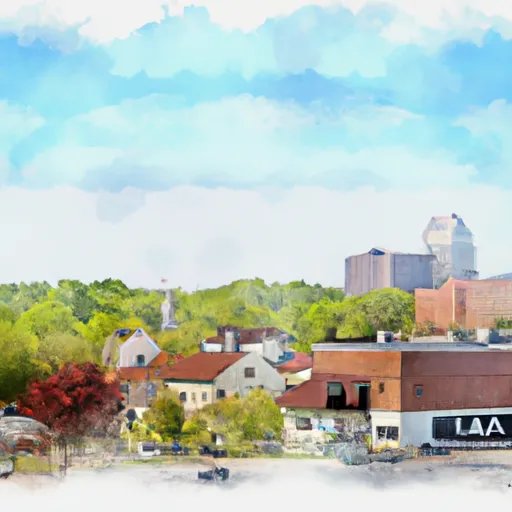-
 Snoflo Premium
Snoflo Premium
Get unlimited access to all our content
With no Ad interruptions! - Start Your Free Trial Login with existing account
Laurel
Eden Index
Climate
8.2
•
Recreation
6.3
•
Community
4.3
•
Safeguard
6.6/10

Laurel, Maryland is a charming city located in Prince George's County, in the central region of the state. The climate in Laurel is characterized as a humid subtropical climate, with hot and humid summers, and mild to cool winters. Summers are typically sunny and warm, with temperatures averaging around 85°F (29°C), while winters are cooler with average temperatures of around 40°F (4°C). Rainfall is evenly spread throughout the year, with an average of 45 inches per year.
Laurel's hydrology constituents mainly revolve around the Patuxent River, which flows through the city. The river provides opportunities for boating, fishing, and other water-related activities. Additionally, Laurel is home to several beautiful parks and outdoor recreation areas, including Patuxent Research Refuge and Fairland Regional Park. These parks offer various recreational activities such as hiking, picnicking, camping, and wildlife observation. The area also has numerous walking and biking trails, providing opportunities for outdoor enthusiasts to explore the city's scenic landscapes.
Overall, Laurel, Maryland offers a pleasant climate, opportunities for outdoor recreation, and a vibrant natural environment, making it an ideal destination for those who enjoy spending time outdoors.
What is the Eden Index?
The Snoflo Eden Index serves as a comprehensive rating system for regions, evaluating their desirability through a holistic assessment of climate health, outdoor recreation opportunities, and natural disaster risk, acknowledging the profound impact of these factors on livability and well-being.
Climate Health Indicator (CHI): 8.2
Laurel receives approximately
1166mm of rain per year,
with humidity levels near 80%
and air temperatures averaging around
14°C.
Laurel has a plant hardyness factor of
7, meaning
plants and agriculture in this region tend to thrive during the non-winter months.
By considering the ideal temperature range, reliable water supplies, clean air, and stable seasonal rain or snowpacks, the Climate Health Indicator (CHI) underscores the significance of a healthy climate as the foundation for quality living.
A healthy climate is paramount for ensuring a high quality of life and livability in a region, fostering both physical well-being and environmental harmony. This can be characterized by ideal temperatures, reliable access to water supplies, clean air, and consistent seasonal rain or snowpacks.
Weather Forecast
Streamflow Conditions
Upper Chesapeake
Area Rivers
Upper Chesapeake
Snowpack Depths
Upper Chesapeake
Reservoir Storage Capacity
Upper Chesapeake
Groundwater Levels
Recreational Opportunity Index (ROI): 6.3
The Recreational Opportunity Index (ROI) recognizes the value of outdoor recreational options, such as parks, hiking trails, camping sites, and fishing spots, while acknowledging that climate plays a pivotal role in ensuring the comfort and consistency of these experiences.
Access to outdoor recreational opportunities, encompassing activities such as parks, hiking, camping, and fishing, is crucial for overall well-being, and the climate plays a pivotal role in enabling and enhancing these experiences, ensuring that individuals can engage in nature-based activities comfortably and consistently.
Camping Areas
| Campground | Campsites | Reservations | Toilets | Showers | Elevation |
|---|---|---|---|---|---|
| Louise F. Cosca Regional Park | 23 | 223 ft | |||
| Andrews AFB Military | None | 269 ft | |||
| Greenbelt Park | 175 | 121 ft | |||
| Cedarville State Forest | 27 | 198 ft |
Nearby Ski Areas
Catastrophe Safeguard Index (CSI):
The Catastrophe Safeguard Index (CSI) recognizes that natural disaster risk, encompassing floods, fires, hurricanes, and tornadoes, can drastically affect safety and the overall appeal of an area.
The level of natural disaster risk in a region significantly affects safety and the overall livability, with climate change amplifying these risks by potentially increasing the frequency and intensity of events like floods, fires, hurricanes, and tornadoes, thereby posing substantial challenges to community resilience and well-being.
Community Resilience Indicator (CRI): 4.3
The Community Resilience Indicator (CRI) recognizes that education, healthcare, and socioeconomics are crucial to the well-being of a region. The CRI acknowledges the profound impact of these elements on residents' overall quality of life. By evaluating educational resources, healthcare accessibility, and economic inclusivity, the index captures the essential aspects that contribute to a thriving community, fostering resident satisfaction, equity, and social cohesion.

